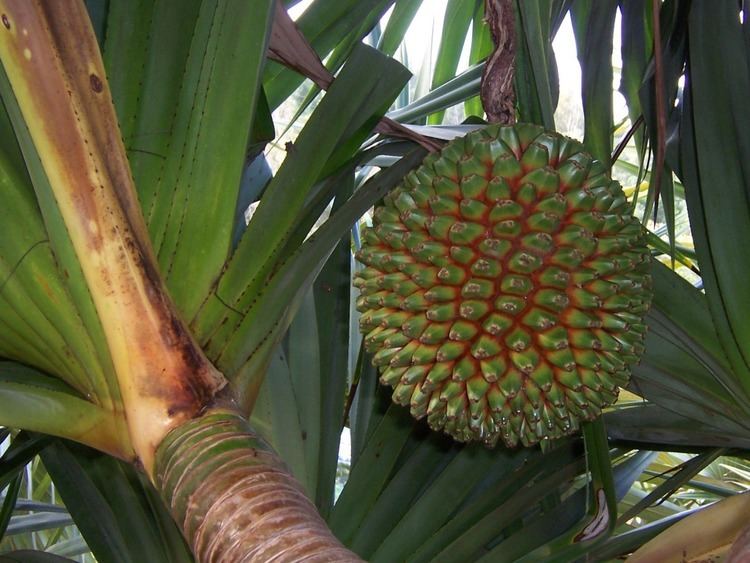Genus PandanusParkinson | ||
 | ||
Pandanus is a genus of monocots with some 750 accepted species. They are palm-like, dioecious trees and shrubs native to the Old World tropics and subtropics. Common names include pandan (/ˈpændən/), screw palm, and screw pine. They are classified in the order Pandanales, family Pandanaceae.
Contents
Description
Often called pandanus palms, these plants are not closely related to palm trees. The species vary in size from small shrubs less than 1 m (3.3 ft) tall, to medium-sized trees 20 m (66 ft) tall, typically with a broad canopy, heavy fruit, and moderate growth rate. The trunk is stout, wide-branching, and ringed with many leaf scars. Mature plants can have branches. Depending on the species, the trunk can be smooth, rough, or warty. The roots forms a pyramidal tract to hold the trunk. They commonly have many thick prop roots near the base, which provide support as the tree grows top-heavy with leaves, fruit, and branches. These roots are adventitious and often branched. The top of the plant has one or more crowns of strap-shaped leaves that may be spiny, varying between species from 30 cm (12 in) to 2 m (6.6 ft) or longer, and from 1.5 cm (0.59 in) up to 10 cm (3.9 in) broad.
They are dioecious, with male and female flowers produced on different plants. The flowers of the male tree are 2–3 cm (0.79–1.18 in) long and fragrant, surrounded by narrow, white bracts. The female tree produces flowers with round fruits that are also bract-surrounded. The individual fruit is a drupe, and these merge to varying degrees forming a multiple fruit, a globose structure, 10–20 cm (3.9–7.9 in) in diameter, and have many prism-like sections, resembling the fruit of the pineapple. Typically, the fruit changes from green to bright orange or red as it matures. The fruits can stay on the tree for more than 12 months.
Ecology
These plants grow from sea level to 3,300 m (10,800 ft). Pandanus trees are of cultural, health, and economic importance in the Pacific, second only to coconut on atolls. They grow wild mainly in seminatural vegetation in littoral habitats throughout the tropical and subtropical Pacific, where they can withstand drought, strong winds, and salt spray. They propagate readily from seed, but also are widely propagated from branch cuttings by local people.
Species growing on exposed coastal headlands and along beaches have thick 'prop roots' as anchors in the loose sand. Those prop roots emerge from the stem, usually close to but above the ground, which helps to keep the plants upright and secure them to the ground.
While pandanus are distributed throughout the tropical and subtropical islands and coastlines of the Atlantic, Indian and Pacific Oceans, they are most numerous on the low islands and barren atolls of Polynesia and Micronesia. Other species are adapted to mountain habitats and riverine forests.
The tree is grown and propagated from shoots that form spontaneously in the axils of lower leaves. Pandanus fruit are eaten by animals including bats, rats, crabs, elephants and monitor lizards, but the vast majority of species are dispersed primarily by water. Its fruit can float and spread to other islands without help from man.
Cultivation and uses
Pandan is used for handicrafts. Craftsmen collect the pandan leaves from plants in the wild. Only the mature leaves are cut so the plant will naturally regenerate. The leaves are sliced in fine strips and sorted for further processing. Weavers produce basic pandan mats of standard size or roll the leaves into pandan ropes for other designs. This is followed by a coloring process, in which pandan mats are placed in drums with water-based colors. After drying, the colored mats are shaped into final products, such as place mats or jewelry boxes. Final color touch-ups may be applied.
Pandan (P. amaryllifolius) leaves are used in Southeast Asian cooking to add a distinct aroma to rice and curry dishes such as nasi lemak, kaya ('jam') preserves, and desserts such as pandan cake. In Indian cooking, the leaf is added whole to biryani, a kind of rice pilaf, made with ordinary rice (as opposed to that made with the premium-grade Basmati rice). The basis for this use is that both Basmati and Pandan leaf contain the same aromatic flavoring ingredient, 2-Acetyl-1-pyrroline. Pandan leaf can be used as a complement to chocolate in many dishes, such as ice cream. They are known as daun pandan in Indonesian and Malay; 斑蘭 (bān lán) in Mandarin; ဆူးေမႊးရြက္ (su mwei ywe) in Myanmar, as ใบเตย (bai toei; pronounced [bāj.tœ̄j]) in Thailand, and as lá dứa in Vietnam. Fresh leaves are typically torn into strips, tied in a knot to facilitate removal, placed in the cooking liquid, then removed at the end of cooking. Dried leaves and bottled extract may be bought in some places. In Sri Lanka, pandan leaves are a major ingredient used in the country's cuisine, it is known as rampe in the Sinhalese language.
Kewra (also spelt Kevda or Kevada) is an extract distilled from the pandanus flower, used to flavor drinks and desserts in Indian cuisine. Also, kewra or kevada is used in religious worship, and the leaves are used to make hair ornaments worn for their fragrance as well as decorative purpose in western India.
Species with large and medium fruit are edible, notably the many cultivated forms of P. tectorius (P. pulposus). The fruit is eaten raw or cooked. Small-fruited pandanus may be bitter and astringent.
Throughout Oceania, almost every part of the plant is used, with various species different from those used in Southeast Asian cooking. Pandanus trees provide materials for housing; clothing and textiles including the manufacture of dilly bags (carrying bags), fine mats or ‘ie toga; sails, food, medication, decorations, fishing, and religious uses.
Selected species
Note: several species previously placed in Pandanus subgenus Acrostigma are now in the distinct genus Benstonea.
